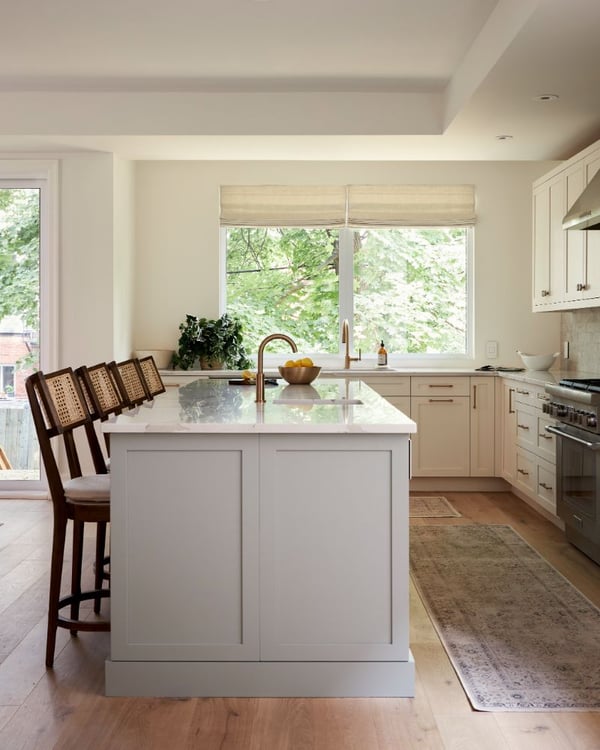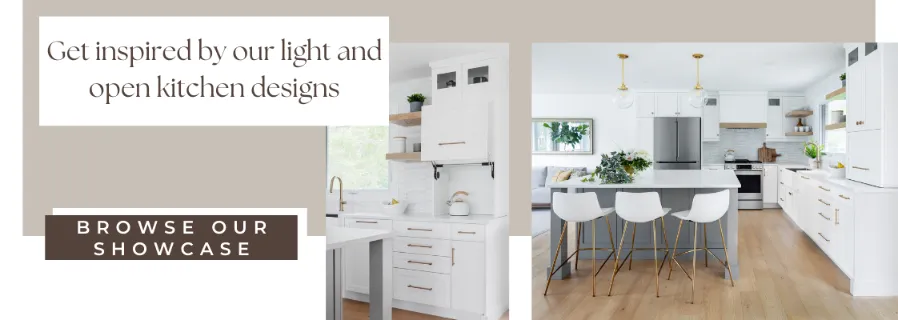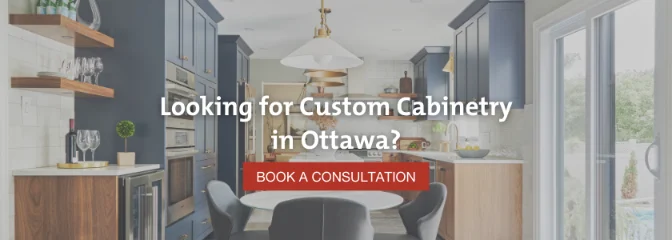19/06/2023 • Blog, Comparisons
Applied Cabinet Panels vs. Integrated Finished Gables
Estimated Read Time: 6 Minutes
When it comes to kitchen cabinet construction, a finished exterior is both a functional requirement and a design aesthetic.
There are two common methods to create a finished appearance on an exposed side of a cabinet box: either with an applied panel or an integrated finished gable.
One manufacturer could have applied panels, while another uses integrated finished gables. Maybe a supplier has both options and you’re unsure of which style best suits your kitchen design.
We’re here to help!
At Deslaurier, we have over 40 years of experience manufacturing custom cabinets. In that time, we’ve crafted beautiful custom kitchens using both applied panels and finished cabinet gables.
In this article, we will explore and compare the distinctive characteristics of applied panels and finished cabinet gables. By understanding these key differences and similarities, you'll be able to make an informed decision when it comes to choosing the right option for your cabinets.
Let’s get started!
|
Table of Contents |
What are Applied Panels?
One way to cover exposed cabinet sides is by using applied panels.
Applied cabinet end panels involve attaching a separate decorative panel to an exposed side of a cabinet box. Most manufacturers will have applied panels extending slightly past the cabinet box and aligned flush with the cabinet door fronts.
The goal is to give it that “finished” appearance to match the rest of the cabinet.
.png?width=800&height=533&name=MicrosoftTeams-image%20(3).png)
If you’ve ever seen an unfinished cabinet box, you’ll know it looks a lot different than it does with a finished end. The cabinet boxes are just made with raw materials like plywood or particleboard.
That’s because it’s a more efficient manufacturing process.
The finishing process is more efficient as the box and decorative applied panel can be manufactured and shipped independently from one another. Integrated finished gables (more below) are fully assembled with the cabinet.
Panels can have both vertical and horizontal applications for features such as tall cabinets or base cabinet sides, the bottom of upper cabinets, or the back of a kitchen island.
What are Finished Gables?
Unlike applied panels, a finished gable is part of the cabinet.
Finished cabinet gables involve integrated gables (sides) that provide the same appearance as the cabinet doors and drawers, creating a cohesive appearance. They're a cabinet box side(s) made to look like the front of the cabinet.
A finished gable can be utilized for exposed sides of a cabinet box that is not covered by another cabinet, wall, or appliance. See the cabinets below:
-8-800x1200-cb6eae5.jpg?width=400&height=600&name=Deslaurier_77Seabert(70140-Amelia)-8-800x1200-cb6eae5.jpg)
All four sides of a cabinet can be finished, but typically the sides or the bottom (on upper wall cabinetry) are most commonly done.
It all depends on what sides are or are not covered by another object in your kitchen design.
Where to use Finished Sides
A finished cabinet is required anytime there is an exposed cabinet side, a change in height or depth between two cabinets, or an appliance opening. The most common application is being used at the end of a cabinet run.
Something like a base cabinet next to a tall pantry cabinet, for instance. The tall pantry cabinet will need a full panel for the finished appearance.
Appliance openings, such as those for refrigerators and hood fans above cooktops, often require panelling to integrate them seamlessly with the surrounding cabinetry.
Sometimes it’s up to the homeowner or designer’s discretion.
For instance, you don’t necessarily need a panel beside something like an integrated dishwasher.
While some homeowners might choose to have a finished cabinet end there (if available), they might not want an applied panel, it all depends on what is available through their cabinet manufacturer.
Design Style
Both methods of finishing cabinet sides will bring benefits and drawbacks depending on your style preference.
Applied panels have the ability to achieve anything from a flat surface to more decorative designs using false doors, wainscot panels, or decor and shaker panels for example, while finished gables are only available in flat sides.

As you can see on the island above, applied panels offer many options to achieve the optimal design aesthetic, with the ability to match your cabinet door styles or incorporate their own unique design into the kitchen.
It’s worth noting that applied panels will have a visible seam at the front of the cabinet, consistent with door gaps.
However, it’s also something you can use to your advantage if you prefer a framed cabinet aesthetic.
For example, at Deslaurier, our applied panels come in ⅝”, ¾”, or 1 ¼” thicknesses. You can get creative with different thicknesses to play with the design and to “frame” your cabinetry how you want it.
Conversely, for integrated cabinet gables there is no additional panel material on either side of the cabinet, just a smooth, finished exterior. However, this also leads to the exposed sides of doors and drawers, which would otherwise be covered with an applied panel.
Installation
One of the biggest benefits of applied panels is their ability to create a better overall finished product at installation.
When it comes to renovations – and many new builds as well – floors and walls are rarely perfectly level. Ensuring the cabinetry is level and there are no visible gaps on the floor or wall is often one of the primary challenges during cabinet installation.
This is one reason why applied panels are far easier to work with than finished cabinet gables. Installers can trim, scribe, and cut panels on-site to expertly fit within the space.
You won’t have any visual gaps that need additional mouldings applied, regardless of how level (or out of level) the floor and wall are.
Alternatively, integrated finished gables are entirely a part of the cabinet box. If the floor or wall is out of level, installers will prop thin pieces of wood called shims underneath or behind the cabinet in an attempt to level the cabinet, which can result in unwanted large gaps.
Repair and Replacement
An unfortunate reality for any finished product is that it can be damaged and require repair or replacement.
Particularly in a kitchen with so much heavy foot traffic, finished cabinet exteriors can be exposed to plenty of accidental dents and dings.
In that regard, applied panels are far more convenient for any service work, repairs, or replacements that need to be done.
If something should happen to the finished end of the cabinet, the applied panel can be detached and fixed or replaced accordingly.
Conversely, an integrated finished gable is a part of the cabinet. They’re much harder to fix and replace because you have to deconstruct the actual cabinet box rather than just remove an exterior panel that’s been attached to it. Oftentimes, the only solution is to order a new cabinet.
Material Flexibility
Applied panels offer increased flexibility with the variety of materials to be used.
With most manufacturers, Integrated finished gables are limited to materials that can have their standard cabinet interior on the other side, typically a basic white or wood grain melamine.
Applied panels remove that issue and increase the potential materials and finishes available on the cabinet exterior and also interior!
It also lends itself to more customization with new materials.
In the world of kitchen cabinets, new and improved materials are always in development. Applied cabinet panels increase flexibility when it comes to manufacturing panels and cabinetry with these new materials.
This alleviates the need for those materials to be made available with melamine on the other side.
Panels make cabinet construction simpler.
Design with Deslaurier Custom Cabinets
As you can see, there are pluses and minuses to either applied panels or integrated finished gables. We hope this article helped you better understand the different methods of utilizing a finished appearance for your cabinets.
If you’re in the market for custom cabinets and kitchen design, Deslaurier Custom Cabinets has everything you need! With over 40 years of experience in our name, we provide our clients with a fully customized design process with our talented team of designers.
Book a consultation today with a Deslaurier design expert at our Ottawa Showroom or schedule a virtual meeting!
Live outside the area? Find a Dealer to connect with near you! Interested in becoming an authorized Deslaurier dealer? Visit our Become a Dealer page to learn more!
.png?width=224&height=80&name=Final%20(3).png)


